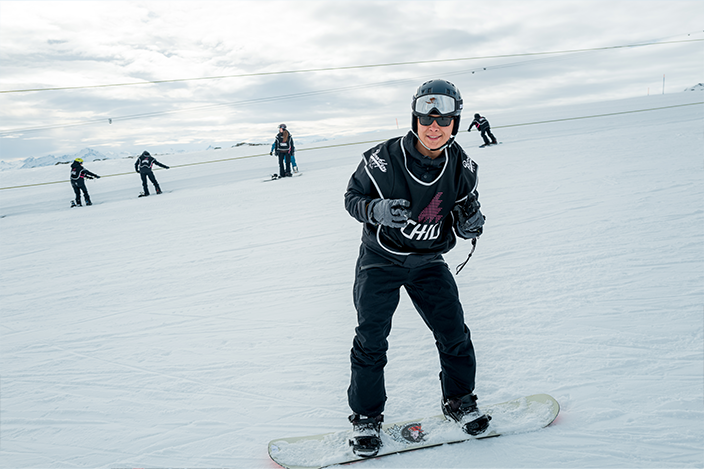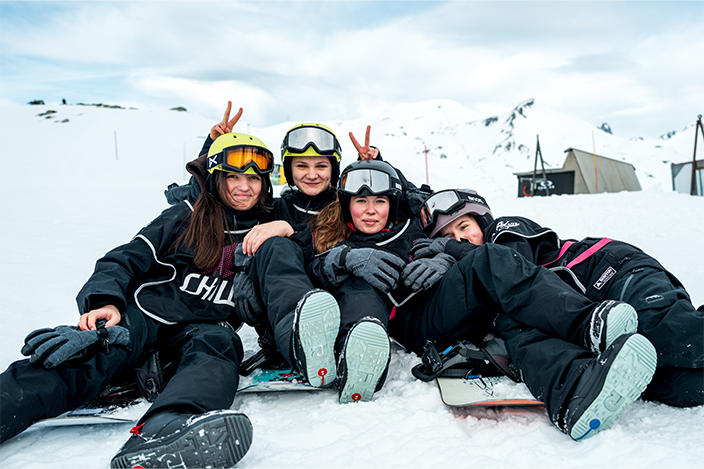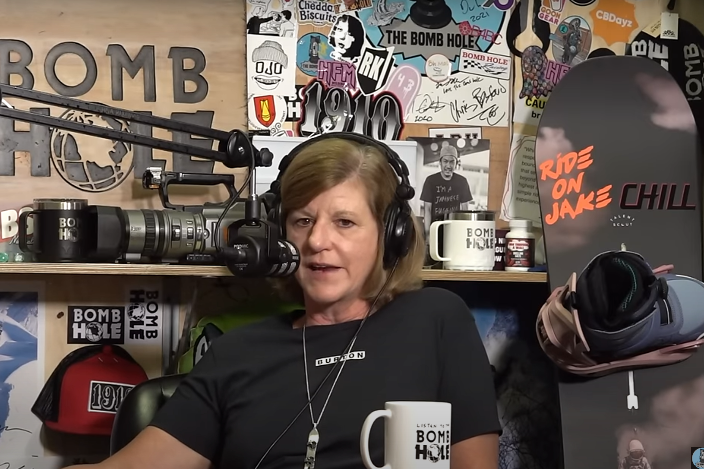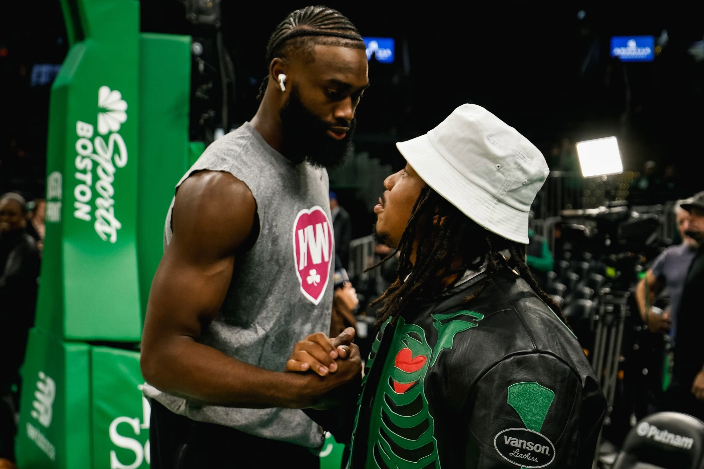The cluttered home office of Jake Burton Carpenter, the man most often credited with putting snowboards on ski slopes, pays homage to his passion. At least 40 snowboards are strewn about, including one from the 1930s that he bought in an antique store. Then there are hundreds of Burton note cards everywhere, propped up against walls, bookshelves and on top of the coffee table, all filled with reminders, ideas and other notes messily scribbled down. “I’m back to focusing on what I love,” Carpenter told Forbes on a picturesque October day in Stowe, Vermont, one month before his death. Sporting shaggy hair and frequently dropping f-bombs, his face lit up as he spoke.
After recovering from testicular cancer in 2012 and then battling back from Miller Fisher syndrome, a rare nerve disease that left him paralyzed—unable to walk, talk or breathe on his own for two months in 2015—Carpenter was back to snowboarding and designing for Burton, the snowboarding company he founded 42 years ago. Now a product manager, he was working on his signature collection called Mine77, which debuted in late 2018.
Plus he knew the business was in great hands. His wife, Donna, who had built Burton alongside him for 37 years, took the CEO reins in 2016. John Lacy, who has worked for Burton for 22 years, became co-CEO last year to help her, after having stepped up when Jake was sick.
The Forbes interview with Carpenter was one of his last interviews. One month after the Forbes visit, he announced to his staff that the cancer was back. “It’s the same tumor as the first time around. We just never got rid of it all. A bit of it hung out in my lymph nodes and got back into business,” said Carpenter. Always the optimist, he insisted the odds were in his favor. His luck ran out for the last time 11 days later on Wednesday November 20. Burton passed away at age 65.
“He was our founder, the soul of snowboarding, the one who gave us the sport we all love so much,” Lacy wrote in an email Thursday morning to employees.
There is no doubt that Carpenter helped put snowboarding on the map. When he started making his snowboards at age 23 in 1977, not one ski mountain in the U.S. permitted snowboarders. He pioneered a largely unknown backyard hobby into a mainstream sport that is now allowed at 473 of the nation’s 476 ski resorts. In those early days, the Burton brand was synonymous with snowboarding, as Carpenter spurred the industry—though he insisted he didn’t invent it. “There was this guy Winterstick and later Simms that got involved. We were all just chasing it. But I was chasing it better than anybody else,” he explained.
Indeed. By developing a snowboard that had the same edge control as a ski, working with resorts to demonstrate the equipment’s safety, setting up global distribution channels and launching the Burton U.S. Open (to date, the longest-running event in snowboarding), Carpenter successfully catapulted snowboarding from a niche hobby to a globally recognized sport.
Started as part of what he called a “get-rich-quick scheme,” the company he left behind has offices in six countries with over 1,000 employees. Last year it had an estimated $400 million in revenue and a 32% share of the global snowboarding market. Burton, owned equally by Jake and Donna at the time of his death, is valued at approximately $700 million.
Carpenter got hooked on riding boards at age 14, when he bought a Snurfer. “A Snurfer was like a primitive snowboard without bindings,” recounted Carpenter, who grew up as the youngest of four children on Long Island. His oldest sister became a model who appeared on the cover of Glamour magazine. His oldest brother died in the Vietnam War. His mother died shortly after that from leukemia when Carpenter was 17. “Her immune system just said f** this,” he recalls.
After graduating from New York University in 1977, he spent a short stint at a small Manhattan investment bank. The stress and long hours Wall Street demanded didn’t match Carpenter’s easygoing temperament. He thought again about the Snurfer. “I kept waiting for someone to take it to the next level and no one was, so I figured I’d do it.”
So he quit and moved to Stratton, Vermont. He got a job as a bartender. The owner let him fiddle in his workshop, and a year later, tapping a $200,000 nest egg left to him by his grandmother, he had a prototype and was hand-making snowboards. “Once I was happy with the design, I grabbed a piece of paper and said, ‘Ok, if I can make 50 boards a day I can earn $100,000 a year and I’ll be good,’” Carpenter recalled. “It was a total get-rich-quick scheme at the time.”
He hired two friends and a relative, and they began making 50 boards a day as planned, spending nearly all of the inheritance left by his grandma. He named the brand Burton, which was his middle name. But sales were disappointingly slow. “We sold only 300 that first year,” Carpenter lamented. “We had three years’ worth of snowboards before I hit the brakes and said we got to stop. Money is going out and it’s not coming in.” His three employees were let go.
He took a step back and realized he was attempting to sell his snowboards to the wrong market. “I’d assumed my target demographic was 22-year-old college students, but it was actually 15- and 16-year-old kids, which is about the same age I was when I got my first Snurfer, who were buying.”
The following year he sold 700 snowboards, and sales continued to double annually for the next few years. By the time he met Donna on New Year’s 1982 not long after midnight, Burton had “maybe one million bucks in sales.” Donna was an 18-year-old Barnard student whose family had homes in Greenwich, Connecticut, and Stratton, Vermont. “Jake told me he made snowboards for a living, and I remember saying, ‘What are those?’ Nobody had heard of it,” she told Forbes. “At first I thought, ‘Oh my god, I’m way too cool, way too sophisticated for him.’ But then there was something that really just drew me to him. He was hard-working, decent, like anti-Greenwich.”
“We were good at different things,” says Donna Carpenter about her successful partnership with her late husband, Jake.
Soon she was traveling to Vermont on weekends to visit Carpenter and working as an unofficial Burton employee. Putting on hazmat suits with air compression, they would go outside, take pieces of laminated wood and hand dip them into polyurethane to make snowboards. “These were some of our first dates,” recounts Donna Carpenter with a laugh. They married in 1983.
In the eighties Burton was growing steadily but was having trouble tapping the mainstream market. Many ski resorts did not want snowboarders on their mountains. Boarders were viewed as a rowdy, uncooperative group of mostly teenagers. Ski mountain operators complained that this new rambunctious bunch was dangerous.
They had a point. Snowboarders simply ignored mountain etiquette. Plus snowboards offered less control than skis, making them difficult to maneuver and nearly impossible to stop.
In order to be welcomed on mountains, Carpenter decided to make his snowboards more like skis. During a trip to Austria with Donna and her family, the newly married couple went from ski factory to ski factory trying to get someone to agree to build this new design.
After numerous rejections, a small ski shop called Keil in Innsbruck, Austria, finally agreed. It was a huge turning point. With the addition of steel edges and a polyethylene base, Burton’s snowboards had the same control as a ski. Today Keil is the single largest snowboard producer, manufacturing exclusively for Burton.
Not long after that trip, Jake and Donna moved to Austria. Inquiries poured in about selling the snowboards—then available only in the U.S.—throughout Europe. “Jake was the product guy, so he asked me, ‘Can you handle this?’” recalls Donna. “I had no idea what I was doing, but I ended up spending the next four and half years setting up distribution in Europe.”
“I always say Jake has always been the one to encourage me to take the next step. He’s been my greatest cheerleader,” says Donna.
Returning to the U.S. in 1989, Donna became Burton’s chief financial officer. The company was experiencing triple-digit growth as snowboarding took off as an edgy alternative to the buttoned-up world of skiing.
“We used to call them suits with spreadsheets,” Donna says of the traditional ski companies. “There was little innovation happening in skiing, and snowboarding was exploding.”
Famous faces began to be associated with the sport, with Burton sponsoring Chloe Kim at age 10 and the Flying Tomato, Shaun White, at 9. ESPN launched the Winter X Games in 1997, televising competitive snowboarding for one of the first times on a major sports network.
Then came the Olympics. Given the rapidly increasing popularity of snowboarding, the International Olympic Committee Executive Board decided to include the sport for the first time at the 1998 Olympic Winter Games in Nagano, Japan.
Burton created the market, but other companies, including Salomon, RIDE and Arbor Snowboards, were quick to follow. Facing competition, Burton diversified. Beginning in 2004, Burton started to acquire a few smaller snowboarding companies as well as skateboarding, surfing and even apparel companies that made T-shirts, shorts and bathing suits. By 2008 Burton owned 12 brands.
What was meant to be a strategic maneuver, however, turned into a major wipeout when the global financial crisis hit. Though Burton had little long-term debt, the company’s seasonal borrowing needs were significant, with snow apparel and equipment still the bulk of the business despite the new acquisitions. But the company was required to maintain a certain ratio of earnings to debt as part of its loan deal. When Burton failed to do so in 2009, J.P. Morgan charged the company $4 million. Jake and Donna stopped taking salaries; others had their pay cut or were laid off. “Not only were we hurt financially, but we’d kind’ve lost our cool,” says Donna. “We’d lost sight of our original purpose and had all of these brands that had nothing to do with snowboarding.
In 2011 Burton, which was now competing in a saturated industry, unveiled a state-of-the-art prototype facility right next to its Burlington headquarters. Dubbed “Craig’s” after the late snowboarding icon Craig Kelly, the 10,000-square-foot R&D facility is where the company takes rider feedback, builds prototypes with machinery including two 3D printers and then takes them out on the snow the very next day.
Riding high: Jake Burton Carpenter on Stowe Mountain in January 2007, a year before the financial crisis wreaked havoc on his business.
GETTY
The next year it dumped all the newly acquired brands except for three—Analog, Anon Optics and Channel Islands—and got back to basics.
When Donna Carpenter became CEO in 2016, earlier than she expected because of her husband’s illness, she penned the company’s first mission statement to cement Burton’s refocus on its roots: “We are riders. We focus on what’s best for riders. Everything else follows.”
She then created the company’s first consumer insights and strategy department and shifted the focus from product to marketing. “I want to tell people that Burton, as a company, how cool we are. And we don’t have to make it up,” says Donna, speaking about the company’s commitment to women’s leadership, philanthropy and sustainability. Under her leadership, Burton became a certified B Corporation in October, committing to balance its profit with purpose.
With climate change a looming threat, the company’s focus on winter may be its key to cool in the short term but an obstacle in the long term. “I’m terrified of it,” admits Donna. Spelled out in massive black letters across a white wall at Burton’s headquarters, this fear is written out plainly: “Without Winter, We’re Done. Without The Next Generation, We’re Gone. Without Guts, We’re Everyone Else.”
One day after Carpenter’s death, co-CEO John Lacy encouraged employees to honor their founder in a fitting manner. “[Tomorrow] is opening day at Stowe, so consider taking some turns together, in celebration of Jake.”
This article was published on Forbes.com on November 22, 2019.



